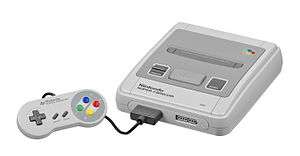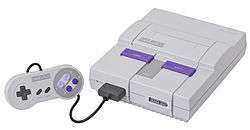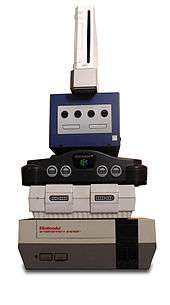Super Famicom Box

The Super Famicom Box is a video game system created by Nintendo that incorporated a "pay to play" mechanism in a manner similar to arcade machines.[1] It was sold only in Japan in the early 1990s and was only available for installation in hotel rooms. The device consisted of Super Famicom console hardware enclosed in a box along with a coin acceptor for time-limited playing of video games. The device included original Super Famicom controllers.
Description
The Super Famicom Box works on the same principle as the Neo-Geo Deck and combines Super Famicom console hardware with a coin acceptor. The system connects to a TV and has two conventional Super Famicom controllers for gameplay. A user can obtain five minutes of gameplay by inserting a 100-yen coin.[1] One peculiarity of the Super Famicom Box (compared to its console counterpart) is its use of system-specific multicarts that contain two or three games per cartridge, unlike the use of conventional cartridges such as with the Nintendo M82 system.[1] These cartridges are much larger than conventional Super Famicom cartridges. The system can accept up to two of these cartridges at the same time. A hinged cover on the front of the Super Famicom Box allows the installation and removal of cartridges. The front cover is secured when closed by a keyed lock at each end. Another keyed lock allows the system to be turned on and off. A special onscreen menu allows the user to select and launch a game. The system incorporates additional hardware not found in the home console to manage the game selection screen and the onscreen messages that direct the user to insert money. The Super Famicom Box cartridge that contains Super Mario Kart, Star Fox and the Super Mario Collection is required to operate the system as it also contains the system BIOS.[1] The games from the Super Famicom Box multicarts are identical to traditional Super Famicom games.
A second revision of the system, the Super Famicom Box 2, used standard Super Famicom cartridges and had a set of multiple internal cartridge slots of the same setup as the Neo-Geo MVS with similarities to the design used by Nintendo on the Nintendo M82.[2] It can accept up to ten standard Super Famicom cartridges.[2]
Specifications
- Processor: 16-bit 65C816 clocked at 3.58, 2.68 or 1.79 MHz (adjustable)
- Working RAM: 128 KB
- PPU (Picture Processing Unit): 16-bit
- Video RAM: 128 KB total, 64 KB for setting plans and 64 KB for sprites
- Number of colors: 256 to 4,096 to 32,768 from the screen according to the graphical mode
- Resolution: 256x224 to 512x448 pixels
- Number of sprites: 128 (maximum 32 per scanning line) each of size 8x8 to 128x128 pixels
- Graphics modes: 8 modes (0-7) each comprising a display type, number of colors and a specific resolution. These graphics modes are used by programmers to facilitate the development of a game. The best known mode is mode 7 (zooming and scaling.)
- Audio processors: Sony SPC700 8-bit S-SMP at 32 kHz, S-DSP 16-bit at 32 kHz
- Sound: 16-bit, 16-channel, ADPCM compression.
- S-SMP: musical synthesizer
- 8-channel ADPCM sound 16-bit at 32 kHz
- Polyphonic support for 8 notes simultaneously
- S-DSP sound processor
- 3-way 16-bit ADPCM at 32 kHz
- Acoustic effects: chorus, reverb, vibrato
- S-SMP: musical synthesizer
- RAM audio: 64 KB + usage of cartridge RAM
- Sound: 16-bit, 16-channel, ADPCM compression.
- Storage: ROM cartridges
- Two controller input ports
- One expansion port
- Support for adding additional processors (Cx4, Super FX (version 1 or 2), SA-1, DSP, and S-DD1 are some of the most well known.)
- Hardware manager for specific system screens
List of games
| Serial no. | Title | Developer | Date |
|---|---|---|---|
| PSS-61 | Super Mario Kart | Nintendo EAD | August 27, 1992 |
| Star Fox | Nintendo EAD | February 21, 1993 | |
| Super Mario Collection | Nintendo EAD | July 14, 1993 | |
| PSS-62 | New 3D Golf Simulation: Waialae no Kiseki | T&E Software | September 18, 1992 |
| Super Mahjong 2: Honkaku 4 Nin Uchi! | I'Max | December 2, 1993 | |
| PSS-63 | Super Donkey Kong | Rareware | November 26, 1994 |
| Super Tetris 2 + Bombliss | Bullet-Proof Software | December 18, 1992 | |
| PSS-64 | Super Donkey Kong | Rareware | November 26, 1994 |
| Super Bomberman 2 | Hudson Soft | April 28, 1994 |
References
- 1 2 3 4 Nicola Salmoria and the MAME Team. "MAME | src/mame/drivers/sfcbox.c". MAME. Retrieved 2013-12-02.
- 1 2 "Nintendo Super Famicom Hotel Box 2". Japan-Games.com. 2006-06-04. Retrieved 2013-12-02.

